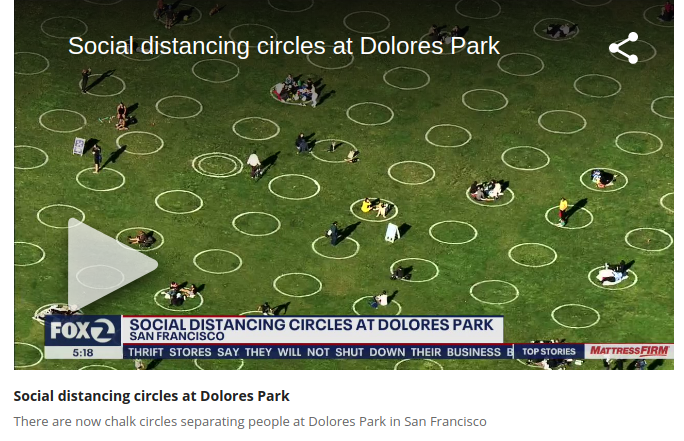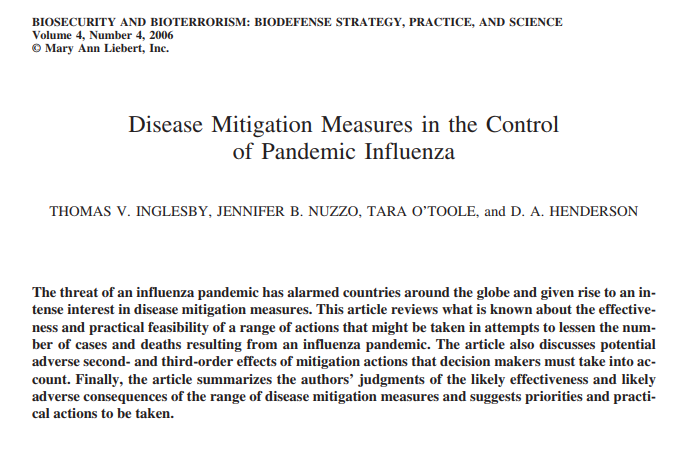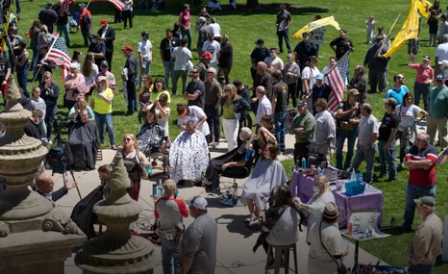The COVID lockdowns continue, although many states are phasing back into permitting many businesses to open under conditions of masking, distancing, reduced patrons, etc. Some states are still heavy in their controls. For example, there was a protest in Michigan this week where barbers and stylists (still forbidden to work) cut hair on the capitol lawn in an act of civil disobedience. They were ticketed by state police, referred to the DA, and could face fines up to $500 and up to 90 days in jail, and lose their professional licenses for their “illegal operation of a business.”

In another example of abject silliness, San Francisco has allowed some parks to open, but in one park, placed social distancing circles on the ground. It is unknown what law enforcement measures will be taken against the non-compliant.
Meanwhile, criticisms of lockdowns, of government measures, and of the media’s general unquestioning approach and promotion of the same, have attracted censorship, shaming, conspiracist labels, de-platforming, verbal threats and even job loss. One source of criticism that I read today (from the American Institute for Economic Research) led me to a 2006 paper, which is the title of this blog.
Although government and media would have the public believe that concerns and responses to pandemics are novel, uncharted territory, and must be heavily managed by government interventions lest society be ravaged and overwhelmed by disease and death, these situations have been considered by experts and opined upon for years. D. A. Henderson, a Johns Hopkins epidemiologist (who died in 2016), is considered the “eradicator of smallpox.” He and his co-authors wrote about disease mitigation in a pandemic 14 years ago. They reject the measures that have been forced upon us all. They find those measures without proven efficacy and to have significant social and economic consequences. Although they specifically considered an influenza, COVID behavior is the same: a viral pathogen that follows biologic and epidemiologic principles.
Some of their recommendations: Wash hands, isolate the sick, support the vulnerable at home as needed with food and financial assistance, offset potential high hospital demand with alternative care sites (e.g. converted gyms), vaccinate once an immunization is available. The other social distancing, economic shut down, long-term school closures, mass “quarantine” (modified house arrest), even general masking measures, are not supported by evidence, and are not advisable.
So, if these measures have been previously discussed and modeled, and much of the official and media response disproven, rejected, OR AT LEAST NOTED TO BE DEBATABLE(!), what is the source of the current approach and controls? How did these measures become accepted, and even bullet-proof to debate? How did science and evidence become usurped by political pressures and unified media programming? How did one set of “experts” become untouchable, immune to criticism, given constant media promulgation… while others are vilified, silenced, intimidated, shamed, slandered? Who benefits? Who controls the levers of power, communication, public relations, the marketing of allowable opinion? Which poorly-evidenced and damaging precedents are now set for the next public health threat? What are the boundaries for minimum death tolerance? Will society be shut down if the promoted modeling shows that a thousand people will die? How can a cost-benefit analysis be considered by those that bear no costs, that have perpetual power and/or uninterrupted income?



“The 2006 Origins of the Lockdown Idea” by Jeffrey Tucker, May 15, 2020. American Institute for Economic Research.
https://www.aier.org/article/the-2006-origins-of-the-lockdown-idea/
“How Fear, Groupthink Drove Unnecessary Global Lockdowns”
https://www.realclearpolitics.com/articles/2020/05/21/how_fear_groupthink_drove_unnecessary_global_lockdowns_143253.html